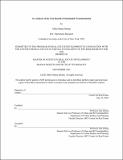An Analysis of the Cost-Benefit of Sustainable Transformation
Author(s)
Menda, Mihir Manoj
DownloadThesis PDF (13.51Mb)
Advisor
Zheng, Siqi
Terms of use
Metadata
Show full item recordAbstract
The real estate industry is a behemoth when it comes to scale by any measure: contributing 10% to the global GDP, and 40% of the planet’s carbon emissions. Sustainable real estate has been on the rise over the last decade with almost all stakeholders across the real estate lifecycle now demanding sustainably built environments. Sustainable transformation ranges intervention in any phase(s) spanning the real estate lifecycle. So, both an asset under construction in its design-development phase, and an operational core asset considering a sustainable retrofit can undergo sustainable transformation.
As countries make commitments to go green and achieve carbon neutrality, sustainable transformation across industries is required to achieve the bold goals set in international arenas like COP26. While there yet exists explicit industry-wide regulations that mandate sustainable real estate globally, some regulatory bodies are pushing sustainable transformation by means of penalties incurred for non-compliance like New York’s Local Law 97. Until governing bodies mandate regulation for sustainable real estate, the industry is dependent on incentivizing asset owners to sustainably transform their assets. The positive statement of capital and equity markets awarding sustainably superior real estate with capital premiums for asset purchase is crucial for the support of sustainable real estate.
In the private sector, the final decision for sustainable transformation of an asset lies with its asset owner. Hence, an asset owner’s buy-in is integral for a real estate asset to undergo sustainable transformation. This thesis proposes a framework that aids real estate owners to evaluate investment into the sustainable transformation of their real estate assets. Whilst the thesis only evaluates the assessment of the cost-benefit of sustainable transformation by building HVAC electrification, the framework can, in general, aid decision-making for any application involving building transformation, as long as it has its corresponding input data.
The framework will be applied on two strikingly different office buildings in two cities in terms of climate, regulation, and market: an office asset of 6.9 million square feet in its design-development phase in Hyderabad, India, and an indicative office asset of 0.9 million square feet in New York, US.
Date issued
2022-09Department
Massachusetts Institute of Technology. Center for Real Estate. Program in Real Estate Development.Publisher
Massachusetts Institute of Technology